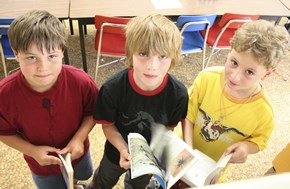BY HEIDI
ULRICHSEN
When Jesse Maloney was a child, he loved reading books and
writing his own stories. Now the young man is passing his love
of the written word onto his eight-year-old nephew, Ashton
Bell-Nisbet.
Maloney, who recently graduated from teacher's college at
Nipissing University, volunteers every Wednesday at the boys'
literacy club at St. James Catholic School in Lively.
The club is part of the school's strategy to improve
literacy among all students, but in particular, boys.
Studies show that boys typically score substantially lower
than girls in language arts tests.
Fathers, grandfathers and other male relatives spend an hour
with their young boys after school reading books, looking at
websites and playing literacy games.
"Throughout the kids' school day, you try to implement as
much literacy as possible. But through the club, you can focus
mainly on the boys and getting them to participate in reading,"
says Maloney.
"We're role models for them. They (the boys) see that we
enjoy reading, so I think it's going to influence them to be
excited."
The school recently received a $12,200 grant from the
province to develop a program to improve boys' literacy.
Developmental reading assessment standardized tests were
done this spring and will be repeated in a year to see if the
boys' scores improve.
Besides the literacy club, the school has also implemented a
book bag program. Boys and girls in Grades 1, 2 and 3 take home
non-fiction books on certain topics to read with their parents.
Older male students are also paired with young male students
and older female students with young female students in the
school's reading buddy program.
Most of the grant money was spent on books and educational
computer software that boys find appealing, says Grade 3
teacher Louise Franklin, who has spearheaded the boys' literacy
strategy at the school.
"We've purchased a whole bunch of humour and action
adventure books that boys love. We've purchased hockey cards
too. They're still reading. We've purchased subscriptions to
magazines like Sports Illustrated for Kids, Chirp and Owl," she
says.
"The boys love all of it. We've had nothing but positive
responses. They are taking these books out of the library, and
they're talking about it. They're actually enjoying what
they're doing, and they want to do it. They're excited to get
their book bags and to come to the boys literacy club."
Girls probably do better in standardized tests because they
enjoy books that are traditionally taught in school, says
Franklin.
"They (girls) like things like Charlotte's Web and Nancy
Drew. They like the character to be developed. Some of them
like the same things as the boys, but they're not as keen when
we say, 'OK, you're taking out a book on snakes'."
Maloney's aspiring-mechanic nephew, Ashton, says he enjoys
reading books about cars, four-wheelers and dirt bikes. He
learns about these subjects and others at the literacy
club.
"We go on the computer, look at pictures, read facts and print
some pictures. We did shark trivia one week. We made books
about Halloween, dinosaurs and cars," he says.
